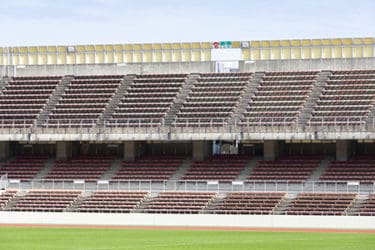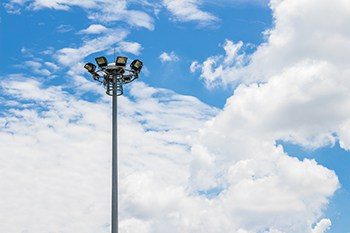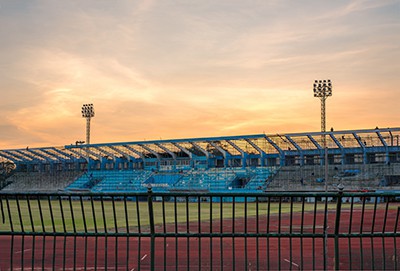The use of solar power has grown in the recent past. However, this is not true for utility-scale solar plants. It is also used for small solar power projects. Using solar power has even reached the entertainment industry.

Sports with their ability to reach huge numbers of people have been used as a place for value promotion for many years. The concepts of energy efficiency and sustainability have been an issue of major focus in the recent past. Many famous stadiums today use solar power to improve the sustainability of their power use.
In many cases, famous stadiums have conducted wide-scale initiatives to boost solar use. The international Olympic committee did one of the largest solar installation initiatives by professional sports. The committee added environmental protection as the third pillar of the Olympics for those wishing to host the games. The use of solar panels and heat collectors has become quite popular at Olympics sports venues globally.
In some cases, the use of solar clean energy at stadiums is usually a purely economic one. The cost of installing renewable energy at stadiums has dropped so much the benefits over time outweigh the cost.
European Sports Arenas that Use PV Panels
Europe has a very mature sports scene. Some of the best teams in various disciplines are found here. A growing list of stadiums on the continent now uses solar power. In fact, most of the sports arenas that have installed PV are in the football or soccer as it is known in the US.

The major drive for stadium solar power installation in Europe is FIFA, which began the Green Goal project in 2003. However, the program debuted in Germany during the World Cup of 2006. Later it debuted in the UEFA Cup held in Switzerland in 2008.
The use of clean energy in stadiums and recreation buildings has come a long way since it was first used in sports arenas. The Badenova-Stadio was the first to use renewable energy source by using 259 KWp of power on its rooftop. This trend soon caught on in the rest of Europe.
Most of the nice stadiums that use solar panels are in the top leagues of Europe such as Serie A, Bundesliga, and Ligue 1. The venue with most solar capacity is the TT circuit in the Netherlands. The racing venue collects solar energy using about 21,000 solar panels that have a peak capacity of 5,600 KWp.
Installing solar panels on the roof is not the only way that these sports teams can be more sustainable. For instance, Arsenal has a power purchase agreement with Octopus energy in the UK. This has made the team 100% sustainable in energy consumption. With such energy conservation, the Gunners will save 2.32 million kilos of CO2 emissions each year. This is about 183 double-decker buses.
Growing Use of Solar in the US
In the US, things are not much different. A growing list of stadiums is turning to solar power. Today, many professional sports in the US have installed solar energy. In fact, a study showed that there were 46 megawatts of power being generated by sports teams in the US. In just five short years, 34 MW of power has been added at 16 nice stadiums. This is about 75 percent of the solar installation in US sports facilities.

Major sports leagues in the US such as the NBA, NFL, MLB, MLS, NASCAR, and IndyCar have embraced energy efficiency. Today, about a third of teams in the NFL, NBA, and MLB all have solar production. In fact, about 42 million Americans have attended an arena vs stadium that has a solar system in place.
This shows that solar energy is playing an increasing role in the energy profile of the US. Many venues now understand that the energy efficiency using solar panels can lead to huge savings. This is a sign that solar is the energy source of the future. In fact, the use of solar has become so common that all Champions of 2018 were from arenas that have solar power sports.
The use of solar by solar power sports is crucial to going green in sports. All of these teams have a lot of influence on and off the pitch. They will help to promote the use of solar energy amongst their fans. It will be important in helping to reduce reliance on fossil fuel, which is damaging our planet.
The largest generators of solar power in the US are the Motor Speedway that produces 9.600 KWs of peak capacity and the Sacramento Kings that buy some of their power from an 11,000 kW solar farm outside of Sacramento. While many teams have installed solar capacity on-site, more teams are buying power from either a private solar plant or a community solar farm.
Sports teams are major generators of solar power in the US. For instance, the Sonoma Raceway in California has a 353 KW solar plant that produces 41 percent of its energy needs. The home of the Atlanta Falcons, called the Mercedez-Benz venue procures enough power for all of its homes games each season.
Use of Solar Power in South American
South America has some of the biggest potentials for solar power in America. However, some nations have exploited this potential more than others have. For instance, Chile has the most solar capacity in the region. Despite this, in terms of sports venues, the title belongs to Brazil. Costa Rica also happens to be the only other nation with sports facilities that use solar.

Although the solar market in Brazil is a fraction of that of Chile, it has made a lot of effort in installing solar at recreation buildings and stadiums. The effort to use solar power came after the nation was given the honor of hosting the World Cup in 2014. This led to some of its biggest stadiums having to be reconstructed to meet FIFA standards.
As a result, about 4 of the 12 stadiums used had solar power installed. This made the nation a superpower in terms of solar sports venues. The Estadio Nacional Mane Garrincha is the site with most solar power. It has the capacity to produce about 2500 KW of solar.
The second position goes to the Estadio Mineirao, which can produce up to 1420 kW of power. The site has received a lot of attention in the recent past. The energy does not just power the stadium; it also goes to the local grid, which serves the needs of almost 1000 homes annually. Once re-development is done, the stadium will be the second globally to receive LEED Platinum Sustainability Certification.
Summary
Solar and arena vs stadium are perfect for each other, they save the venues money while also promoting solar use to the masses. More venues globally should definitely embrace the use of solar energy.